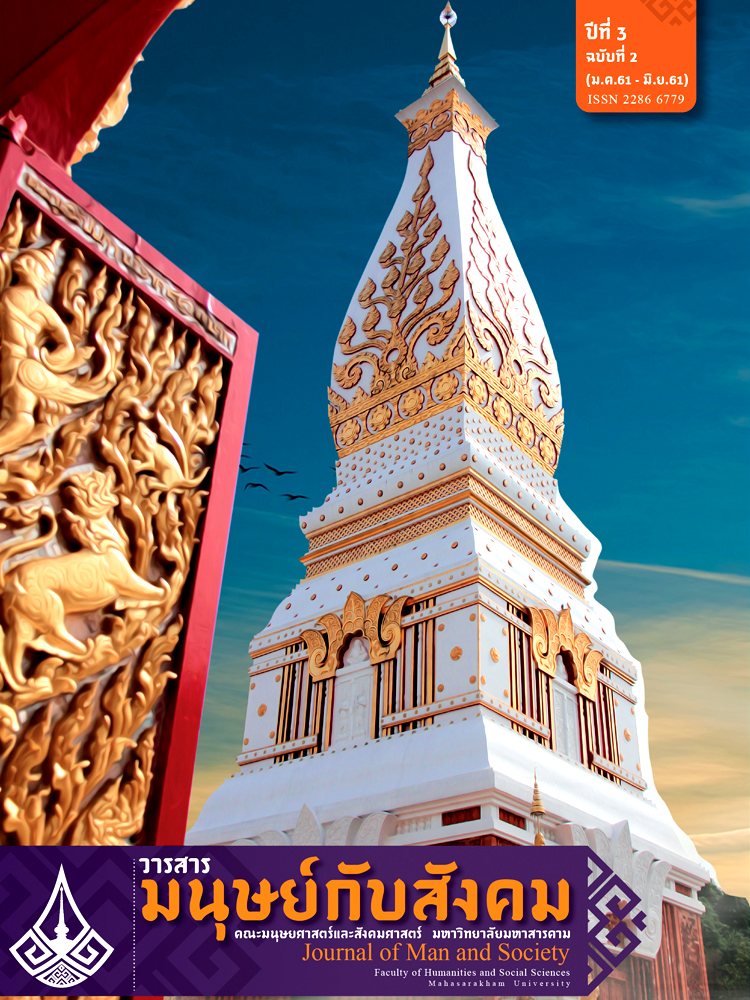Buddhist Tourism: A Case Study of Landscape of Buddhist Meditation Teachers in Lower Northeast
Main Article Content
Abstract
This research aims to study of the Landscape of Buddhist meditation teachers,Buddhist Resources and todevelopBuddhist tourism route Related to Buddhist meditation teachers in lower northeast. The methodology of this research is qualitative. The in-depth interviews and focus group discussions are as the tools by using the specific samples and sampling. The results of the research found that the origin of the Buddhist meditation teachers in northeast is UbonRatchathani province; which spread from the DhammayuttikaNikaya in Bangkok.The monasterieswere rebuilt and refined in the same denomination in the province of Ubonratchathani and neighboring provinces. The Buddhist meditation teachers which are important and remarkable in northeast, that is, Sua Kuntasilo and Mun Phurithatto. But in lower northeast Sua Kuntasilo is considered a dominant role than MunPhurithatto. For the other lower northeast, Nakhonratchasima and Surin provinces are the important spread of the Buddhist meditation masters.For Buddhist Resources Related toBuddhist meditation masters
which are prominent for Buddhist tourism, it can be organized into six groups, as follow, group of important monasteries; group of pagoda; group of museum; group of sacred Buddha statue; group of relic and group of doctrines. Moreover,there are 3 main routes, that is,route of Buddhist tourism within UbonRatchathani province; the two routes links between provinces. Most of them can be organized under the name as “the teacher worship route”.
Article Details

This work is licensed under a Creative Commons Attribution-NonCommercial-NoDerivatives 4.0 International License.
เนื้อหาและข้อมูลที่ตีพิมพ์ลงในวารสารมนุษย์กับสังคม ถือเป็นข้อคิดเห็นและความรับผิดชอบโดยตรงของผู้เขียนซึ่งกองบรรณาธิการวารสารไม่จำเป็นต้องเห็นด้วยหรือร่วมรับผิดชอบใดๆ
บทความ ข้อมูล เนื้อหา รูปภาพ ฯลฯ ที่ได้รับการตีพิมพ์ในวารสารมนุษย์กับสังคม ถือเป็นลิขสิทธิ์ของวารสาร หากบุคคลหรือหน่วยงานใดต้องการนำทั้งหมดหรือส่วนหนึ่งส่วนใดไปเผยแพร่ต่อต้องอ้างอิงวาสาร
References
กรมการท่องเที่ยว. (2558). แผนปฏิบัติการพัฒนาแหล่งท่องเที่ยวที่มีศักยภาพของประเทศพ.ศ. 2558-2560. [ออนไลน์]. ได้จาก: http://www.mots.go.th/ewt_dl_link.php?nid=7114. [สืบค้นเมื่อ วันที่ 23 ตุลาคม 2560].
กระทรวงการท่องเที่ยวและกีฬา. (2558). นโยบายและยุทธศาสตร์การท่องเที่ยว พ.ศ.2558-2560. [ออนไลน์]. ได้จาก: http://www.mots.go.th/ewt_dl_link.php?nid=7114. [สืบค้นเมื่อ วันที่ 22 ตุลาคม 2560].
ดำรงราชานุภาพ, สมเด็จพระเจ้าบรมวงศ์เธอ กรมพระยา. (2518). ตำนานพุทธเจดีย์. พิมพ์ครั้งที่ 3. กรุงเทพฯ: คุรุสภา.
ธรรมปิฏก, พระ, (ป.อ. ปยุตโต). (2538). พุทธธรรม. กรุงเทพมหานคร: มหาวิทยาลัยมหาจุฬาลงกรณราชวิทยาลัย.
ธัมมธโรภิกขุ. (2554). ธรรมประวัติหลวงปู่จาม มหาปุญโญ ผู้มากมีบุญ. กรุเทพมหานคร:มติชน.
ธีระพงษ์ มีไธสง. (2556). ฮดสรง ภูมิปัญญาพื้นบ้านพิธีเถราภิเษกพระสงฆ์ในภาคอีสาน.มหาสารคาม: ตักสิลาการพิมพ์.
มาโนช พรหมปัญโญ. (2556). แนวทางการเตรียมความพร้อมการท่องเที่ยวเชิงพุทธของจังหวัดอุบลราชธานี. [ออนไลน์]. ได้จาก: www.tourismtaat.siam.edu/images/magazine/m8b2/w4pdf. [สืบค้นเมื่อ วันที่ 23 ตุลาคม 2560].
ราชบัณฑิต. (2542). พจนานุกรมฉบับราชบัณฑิตยสถาน พ.ศ. 23542. กรุงเทพมหานคร:นานมีบุ๊คส์ จำกัด.
สุทิตย์ อาภากโร, พระมหา, (อบอุ่น). (2554). รูปแบบและเครือข่ายการเรียนรู้ของแหล่งท่องเที่ยวประเภทวัดในประเทศไทย. [ออนไลน์]. ได้จาก: Library.nhrc.or.th/ulib/searching.php. [สืบค้นเมื่อ วันที่ 23 ตุลาคม 2560].
Feilden, B. andJokilehto J. (1993). Management Guidelines for the World CulturlaHeritage Sites. Rome (Italy): ICCROM.
UNSCO. (2005). The World Heritage Convention. [Online]. Available from: http://whc.unesco.org/en/con vention/. [Accessed 23 October 2017].


